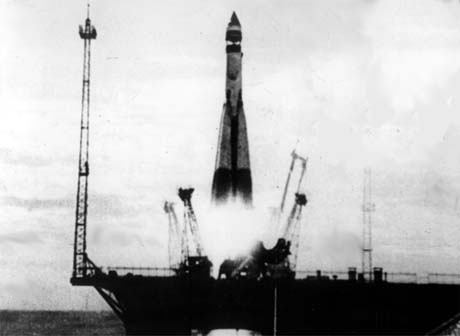| SPACE TODAY ONLINE COVERING SPACE FROM EARTH TO THE EDGE OF THE UNIVERSE | ||||||||||
| COVER | SOLAR SYSTEM | DEEP SPACE | SHUTTLES | STATIONS | ASTRONAUTS | SATELLITES | ROCKETS | HISTORY | GLOBAL LINKS | SEARCH |
European Space Agency will celebrate Sputnik with...
50 Satellites on the 50th Anniversary
The European Space Agency's Arianespace launch company plans to blast 50 satellites to space on one rocket in 2007 to celebrate the 50th anniversary of the first-ever space satellite.
Sputnik 1
Each of the 50 will be a tiny nanosat weighing just one kilogram (2.2 lbs.).
Just because they are small doesn't mean the tiny satellites won't be functional.
One small satellite already in orbit weighs about 14 lbs. (6.5 kg) and carries a camera, computer, GPS navigator, and propulsion and attitude control systems. It's SNAP-1 built by the British satellite company Surrey Satellite Technology Limited and launched in June 2000.
That compares with commercial communications satellites they weigh as much as 16,000 lbs.
The nanosats will commemorate the launch by the old Soviet Union on October 4, 1957, of the basketball-sized Sputnik 1, the first human-made object to leave Earth's atmosphere.
The 50 nanosats probably will be dropped off by their Ariane rocket in orbits around 200-1,000 miles above Earth.
The Soviet Union followed the first satellite a month later with Sputnik 2, which carried the dog Laika to space. The United States launched its first satellite, Explorer, in February 1958.
The nanosats will be launched for the International Astronautical Federation. Each nanosat will represent a different country. Each will carry a scientific experiment designed by researchers at universities or science organizations in its country.
The satellites will be expected to work two years in orbit.
Satellite Firsts
Ten nations or groups around the world have accomplished the feat from the launch of the first satellite in 1957.
Soon, there may be 11. Iran has said it is building a launchpad and wants to launch a satellite by March 2005.
So far, the majority of satellites have been built by Russia and the United States, but the countries of Western Europe in the European Space Agency, as well as Japan, China, India, Canada, Israel, Brazil and others have been actively engaged in satellite development.
We refer to a spacefaring nation as a country with a rocket powerful enough for space launches. Spacefaring nations are those which launch their own satellites to orbit. They also launch satellites for others who do not possess the capability.
Below, in chronological order, are the first countries to loft their artificial moons to orbit above Earth:
Sputnik One rides Old Number Seven
1957 NOVOSTI PHOTO
A Missed Anniverary »
A Turning Point in History »
First American Satellite »
How High is Space? »
- USSR
1957 Oct 4
satellite: Sputnik 1
rocket: Old Number Seven
launch site: Baikonur Cosmodrome
- USA
1958 Jan 31
satellite: Explorer 1
rocket: Jupiter-C
launch site: Cape Canaveral
- France
1965 Nov 26
satellite: Asterix 1
rocket: Diamant
launch site: Algeria
- Japan
1970 Feb 11
satellite: Ohsumi
rocket: Lambda 4S-5
launch site: Kagoshima
- China
1970 Apr 24
satellite: Mao 1
rocket: Long March-1
launch site: Inner Mongolia
- Great Britain
1971 Oct 28
satellite: Black Knight 1
rocket: Black Arrow
launch site: Woomera Australia
- Europe
1979 Dec 24
satellite: CAT
rocket: Ariane
launch site: Kourou, French Guiana
- India
1980 Jul 18
satellite: Rohini 1
rocket: Satellite Launch Vehicle
launch site: Sriharikota Island
- Israel
1988 Sep 19
satellite: Horizon 1
rocket: Shavit
launch site: Negev Desert
- Iran
2009 Feb 3
satellite: Omid (Hope)
rocket: Safir-2 two-stage
launch site: Semnan
Dasht-e-Kavir desert
- North Korea
2012 Dec 12
satellite: Kwangmyongsong 3
(Lode Star 3)
rocket: Unha three-stage
launch site: Sohae
Satellite Launching Station
Satellites are part of daily life, used around the world for communications, weather forecasting, navigation, observing land, sea and air, scientific research, military reconnaissance and numerous other purposes.
In addition, hundreds of men and women have lived and worked aboard space shuttles and space stations, which are manned satellites in Earth orbit.
Top of this page Satellites Search STO STO Cover Questions © 2004 Space Today Online

